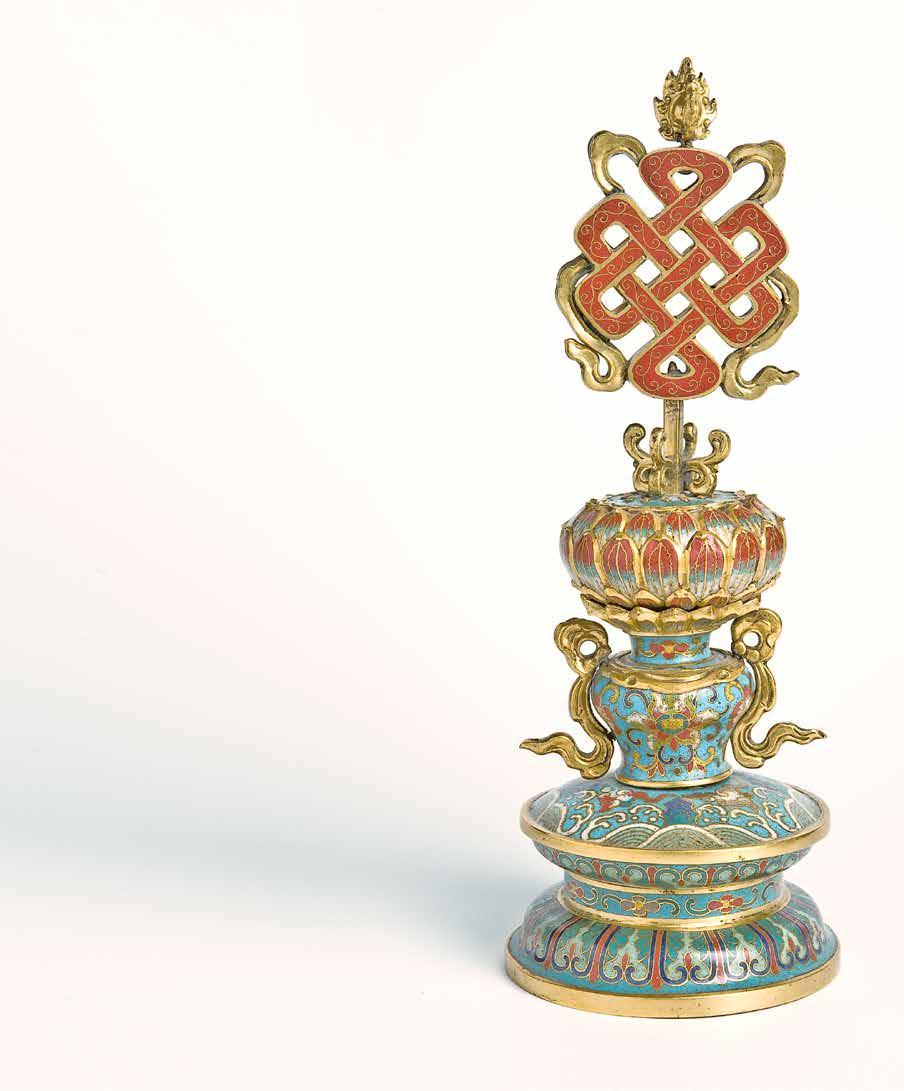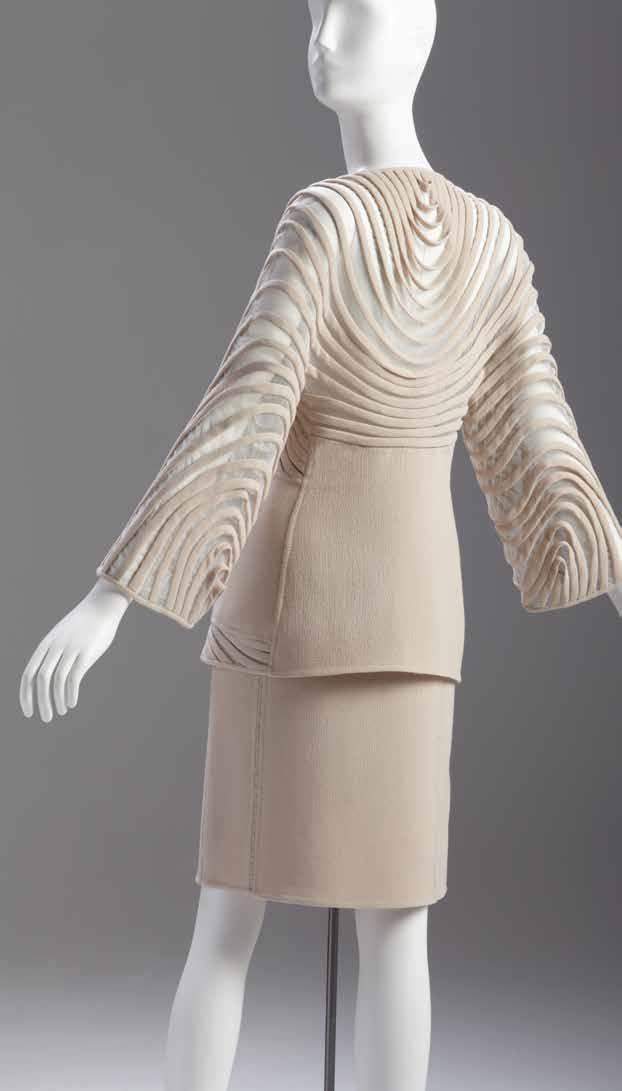
8 minute read
Ann Morton: The Violet Protest and the 2019 Phoenix Art Museum Artists’ Grants Recipients Exhibition
ANN MORTON: THE VIOLET PROTEST
MARCH 10 – SEPTEMBER 5, 2021 MARSHALL AND HENDLER GALLERIES In January 2020, the 2019 Arlene and Morton Scult Artist Award recipient Ann Morton announced an open call for textile artists and makers across the United States and Puerto Rico, asking them to participate in her latest collaborative art installation. Her vision? To create a large-scale work that unites makers of varying political ideologies and encourages bipartisan collaboration.
COLLABORATE C R E AT E
Entitled The Violet Protest, the installation would consist of 8” x 8” square textile units that use equal parts of red and blue materials, symbolizing the union of opposing U.S. political ideologies. Morton would then configure the crowdsourced materials into the letters “U” and “S,” with the red and blue blending to create the overall impression of the color violet. Due to the COVID-19 pandemic and the resulting temporary closure of Phoenix Art Museum, the Museum’s presentation of The Violet Protest was put on hold. This March, however, Arizona audiences will finally have the opportunity to experience this imposing, timely work derived from Morton’s imagination and created with the help of more than 1,000 creatives across North America. On view in the Museum’s Marshall and Hendler galleries, The Violet Protest will feature textile squares stacked into the letters “U” and “S” as originally planned, but Morton will additionally arrange squares across various gallery walls to ensure every maker who contributes to the project has their work displayed. The open call for submissions is still underway, with a deadline of February 1, 2021 for makers who wish to have their work included in the installation’s initial exhibition. (As of early November, Morton had secured commitments from nearly 1,600 volunteers representing all 50 states as well as British Columbia and Alberta in Canada, who have pledged to make just over 12,000 squares.) However, Morton will continue to accept squares up to August 1, 2021. These final submissions will be added to The Violet Protest over the run of the exhibition, providing viewers with the opportunity to see the work grow. Once Morton’s installation at Phoenix Art Museum ends on September 5, 2021, The Violet Protest will live on, albeit in a different form. After it’s disassembled, Morton will send squares from the project to each U.S. Senator and Representative, accompanied by a photo of the full work and a letter calling for elected officials to come together, prioritize the representation of their diverse constituencies, and reject political divisiveness. Organizing and creating this collaborative installation during a pandemic certainly had its challenges, said Morton, who works primarily in fiber art and has organized previous collaborative public-art projects, including ReThanks (2017) and the award-winning Ground Cover (2013). However, through the use of various digital technologies, including monthly e-newsletters and the video-
CONTINUED ON PAGE 14
ABOUT THE ARLENE AND MORTON SCULT ARTIST AWARD AND THE PHOENIX ART MUSEUM ARTISTS’ GRANTS
Each year, Phoenix Art Museum presents two significant recognition opportunities for contemporary artists based in Arizona. The Arlene and Morton Scult Artist Award is presented to a midcareer artist whose work demonstrates a sustained degree of excellence and commitment to contemporary art. Selected by a jury, the recipient receives a $5,000 prize and is invited to present work in a solo exhibition at the Museum the following year. Conversely, the Phoenix Art Museum Artists’ Grants, formerly the Contemporary Forum Artists’ Grants, are designed to support and encourage emerging contemporary artists practicing in Arizona. A jury selects up to five grant recipients, who receive $2,000 each and also present work in a group exhibition at the Museum the following year. The jury for both the 2019 Scult Artist Award and the 2019 Artists’ Grants was composed of Kate Green, Executive Director of Museum of Contemporary Art, Tucson; Tyler Cann, Head of Exhibitions and Pizzuti Family Curator of Contemporary Art at Columbus Museum of Art; and artist Matt Magee, who was named the 2017 Arlene and Morton Scult Artist Award recipient.

All told, when these squares finally do go to Congress, they will carry with them echoes of this time—physically in how some of the squares have manifested through messages conveyed in imagery and words, but also in spirit, as I believe that all of our collective energy is imbued in these Violet Protest squares.”

ANN MORTON
FROM PAGE 13 conference service Zoom, she was able to stay in touch with and create a sense of connection among her diverse groups of volunteers.
“I’ve met with groups all over the country, from felters and weavers’ guilds, to quilters and knitters/crocheters, in places like Minnesota, Pennsylvania, Georgia, Kansas, Illinois, New York, Virginia, New Jersey, and many throughout Arizona,” she said. Through these platforms, Violet Protesters have also made masks together, discussed the country’s racial unrest, and used square-making as an outlet for expression and belonging during this unprecedented moment in history

Nonetheless, despite the challenging times in which The Violet Protest has been orchestrated and created, Morton is confident the end result of the collective work will yield something truly meaningful and unique.
“All told, when these squares finally do go to Congress, they will carry with them echoes of this time—physically in how some of the squares have manifested through messages conveyed in imagery and words,” she said, “but also in spirit, as I believe that all of our collective energy is imbued in these Violet Protest squares.”
To participate in The Violet Protest, or to follow the project’s progress through a heat map of participation across all 50 states, visit violetprotest.com.

Ann Morton: The Violet Protest is organized by Phoenix Art Museum. It is made possible through the generosity of Arlene and Morton Scult, with additional support from the Museum’s Circles of Support and Museum Members.
image credits: page 12: Ann Morton, Violet Protest composite, 2020. Makers (top to bottom, left to right): Heather Kirschner - Mesa, AZ; Cheryl Hopper - Washington, PA; Azra Kearns - Phoenix, AZ; Doerte Weber - San Antonio, TX; Carol Sanger - Phoenix, AZ; Mary Logue - Golden Valley, MN; Katie Leinweber - Scottsdale, AZ; Candace Wilkinson - Phoenix, AZ; Hannah Allen - State College, PA; Tané Clark - Tempe, AZ; Wendy Raisanen - Phoenix, AZ; Bonnie Scott - Salem, VA; Maxene Harlow - Clarksdale, MS; Tara Ritacco - Carlsbad, CA. page 13 (top): Audrey Good - Mesa, AZ; (bottom, left to right) Nancy Nakamoto - Torrence, CA; Kitty Spangler - Pittsburgh, PA; Cheryl Goodberg - Marana, AZ; Maureen Craddock - N. Massapequa, NY. right (top to bottom): Made by Lucinda Carroll, Port Charlotte, FL. Square of the Week – 9/28 – 10/4, 2020 (in honor of John Lewis); Made by Savannah Kay Gordon, Beaverton, OR. Square of the Week – 9/14 – 9/20, 2020 (the week we lost RBG); Made by Rachel Bye, St. Paul, MN. Square of the Week – 8/24 – 8/30, 2020. All images courtesy of the artist.
RECOGNIZING CONTEMPORARY AZ ARTISTS
MARCH 10 – SEPTEMBER 5, 2021 MARSHALL AND HENDLER GALLERIES
This March, Phoenix Art Museum will present works by emerging Arizona-based contemporary artists who were named Phoenix Art Museum Artists’ Grants recipients in 2019. Previously postponed due to the Museum’s temporary closure necessitated by the COVID-19 pandemic, the exhibition will feature drawings, sculptures, and mixed-media works by Christina Gednalske, Danielle Hacche, Lena Klett, Nazafarin Lotfi, and Kimberly Lyle, who represent the Museum’s first all-women grants cohort and who have collectively exhibited work across the globe in countries such as the United States, Italy, Mexico, Panama, England, Venezuela, Germany, Ecuador, South Korea, and Spain.
Both Klett and Lyle, who received their MFAs from Arizona State University, have developed practices that rely on sound, sculpture, and new-media and interactive technologies. Klett’s drawings, sculptures, and videos explore how knowledge is formed through intuition, interaction, and observation, while Lyle’s interdisciplinary works probe humanity’s relationship to systems of communication, learning, and technology, effectively challenging the boundaries between languages, human and machine, past and present. Made of pastel and gouache, Hacche’s geometric, hard-lined abstractions, by contrast, emphasize materiality and a dedication to process versus a specific meaning or message. Born in the United Kingdom but now based in Phoenix, Hacche draws inspiration from 20th-century modernist art and architecture, particularly the German Bauhaus and Brutalist art movements.
Gednalske, who is originally from Sioux Falls, South Dakota, uses video, writing, photography, painting, and performance to examine presence through body, memory, and place, while Lofti, an Iranian-born artist, creates dynamic works that explore the forces of opposition, tension, and harmony and how they allow for possibility and growth. “These emerging contemporary artists are examining complex subjects tied to human perception and identity,” said Gilbert Vicario, the Museum’s Deputy Director for Curatorial Affairs and the Selig Family Chief Curator, who curated the exhibition. “We are excited to share their poignant and dynamic artworks with our audiences in Arizona to illuminate how abstraction as a visual language provides the opportunity to contemplate and reframe our individual and collective realities.”

The 2019 Phoenix Art Museum Artists’ Grants Recipients exhibition is organized by Phoenix Art Museum. It is made possible through the generosity of the Museum’s Circles of Support and Museum Members.

image credits: (above) Christina Gednalske, Extensions, 2015. Video. Image courtesy of the artist. (left) Nazafarin Lotfi, Learning to Hold, 2019. Papier-mâché, acrylic paint, ink, and graphite. Courtesy of the artist.









